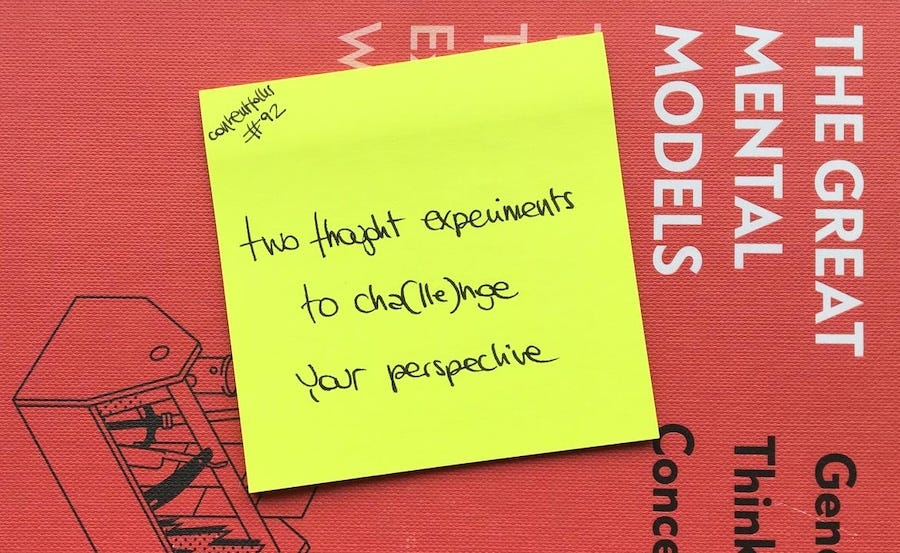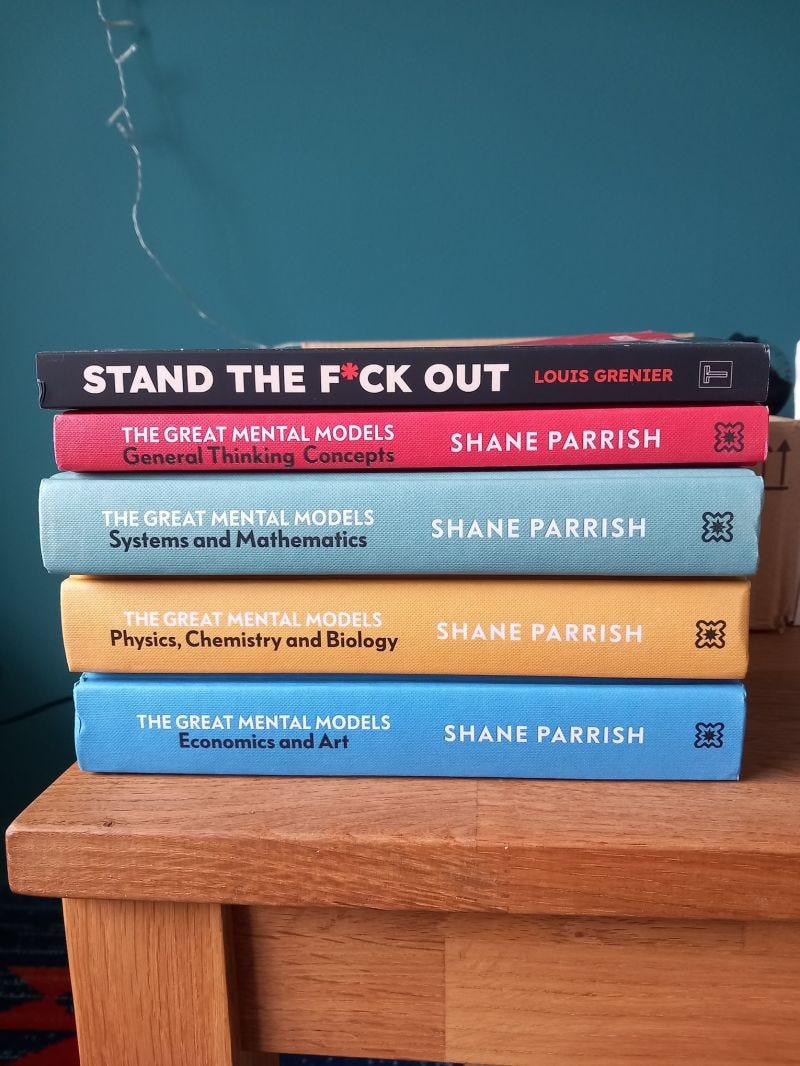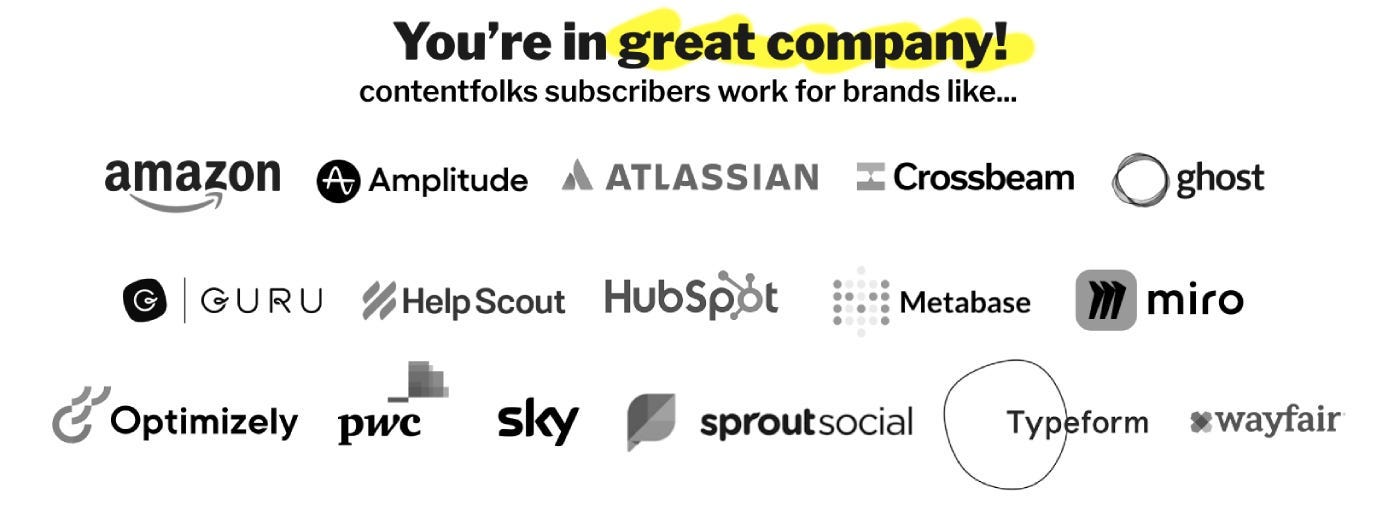cf #92: two thought experiments to cha(lle)nge your perspective
...what if you were a different person with an extra million dollars?
You are reading contentfolks—a monthly(ish) blend of sticky notes, big content ideas, and small practical examples. Thank you for being here! ~fio
Hey there 👋
I’ve been spending time recently with The Great Mental Models, a book set with a self-explanatory title and a delightful cover palette.* One of the chapters in the red book inspired me to re-edit a previous issue of this newsletter about thought experiments—specifically, the “what if?” experiments that can help you make better decisions, faster.
Enjoy!
When things change & you need to change with them
If you’ve ever gone through a growth phase, whether as a solo marketer or as part of your org’s trajectory, you may have encountered this sentence: what got us here won’t take us there. It acknowledges that there are inevitable inflection points where your current mental models, processes, and knowledge become obsolete; to move forward, you need to re-evaluate your existing systems and then upgrade—or maybe even completely redesign—them.
Inflection points have different causes. Maybe your business reaches a notable scaling milestone, like crossing the 100+ employee mark, passing $50m ARR, onboarding more clients than you have bandwidth for. Maybe there is a significant shift in the market, as seen in the past year with the large-scale adoption of generative AI and the end of the Google SERP as we knew it. Maybe you recently switched jobs or are about to get promoted at your existing one. And maybe you’re just experiencing one of the usual tech events—hello acquisitions, mergers, hypergrowth phases, reorgs, layoffs, IPOs, funding rounds, pivots, exits & co.
Whatever the catalyst, you hit an inflection point and soon thereafter BAM!, things stop working like they used to. You’d been doing things right until now, but in this new reality you don’t quite know what doing the right things looks like.
This is where you usually need a shift in mindset, a recalibration of your processes and goals, and new decision-making frameworks. A useful approach I’ve found is running a bunch of “what if?” thought experiments.
From the red book in the Great Mental Models set:
Thought experiments are the sandbox of the mind, the place where we can play with ideas without constraints […] they offer a powerful tool for clarifying our thinking, revealing hidden assumptions, and showing us unintended consequences.
The power of thought experiments lies in their ability to create a simplified model of reality where we can test our ideas [… They] offer a reminder that some of the most profound insights and innovations start with a simple question: What if?
1. The ‘what if you were a different you’ thought experiment
We all have biases and preferences that affect our decisions more than we give them credit for. At work, they inform the formats we gravitate towards, the tactics we’re willing to investigate, the tools we choose. I am clearly biased towards the written word, which is why you are reading this instead of watching my YouTube channel 😉
This thought experiment is about acknowledging what got you this far, and imagining what things would look like if you were a different person.
For example: you may have strong beliefs about what your customers want based on past data, tenure, and experience. That’s your bias right there. But now growth is stalling and what worked before doesn’t seem to be as effective. Run the thought experiment and ask yourself:
What if I was a new hire with no prior knowledge whatsoever? What research would I prioritise to get a fresh perspective?
What if I were an external consultant with no emotional attachment to the brand? What hard truths might I point out?
What if I were a competitor trying to take us down? What perceptions could I exploit to my advantage?
The goal is not to do a complete 180 and either destroy your brand or abandon everything you know. You just want to spot opportunities you may have ignored because of your biases and investigate them further.
A practical example 💡
Throughout most of 2023, I was extremely wary of genAI tools and reluctant to incorporate them into my workflows. I’d had a few bad experiences with ChatGPT hallucinations and straight up decided the entire category was not worth my time.
But then I joined Float, and realised my bias could make my team hesitant to experiment. Not a good look for a senior lead! So at the end of 2023, I started running this thought experiment:
What if I were an enthusiastic early adopter who uses AI to do everything?
What if I genuinely believed AI tools could be useful?
And the most troubling of them all: What if I was someone who didn’t care how content was made, only whether people found it valuable?
I tend to learn by doing, so I organised an AI-focused R&D day for the team; I tinkered with predictive GPT models for decision-making; I tried editing multiple content formats with Claude; I queried large datasets; I even started building a clicker game, which I had wanted to do forever.
I was extremely annoyed at how good of a thought partner Claude was and how overall augmented I felt—and that was also my cue to update my belief system asap. 15 months later, ChatGPT and Claude are permanently open tabs in my browser, and they feel like they’ve been part of my tool stack forever.1
2. The ‘what if you had an extra $1mil’ thought experiment
Sometimes your brain sees a constraint and automatically restricts thinking. You make decisions not because they’re the best ones to make, but because they are the best ones given your current team, time, budget, and situation—and you often do it unconsciously, without noticing the difference.
This thought experiment challenges you to remove a real constraint: money. The goal is not to come up with bananapants ideas and then demand the budget to get them done, but to understand how your awareness of existing constraints might have limited your vision and execution so far.
A practical example 💡
Because I gravitate towards pragmatic execution more than speculative planning, I occasionally like to cha(lle)nge my approach and wonder: what would I do differently if Float’s Director of Marketing gave me an extra $1mil tomorrow?
This thought experiment forces me to pair what is possible with what is ideal, so I can try to work at the intersection of the two. Right now, I have a fairly good idea of what I would do with an extra million;2 and while I won’t tell you because I’ve got to keep some Float secrets, the larger point remains: knowing the desired state makes it easier to reverse engineer the path to get there.
I recommend giving these experiments a try—if nothing else, thinking about being a different person with an extra million dollars makes for a fun work break 😉
To be clear, I still struggle with several aspects of using AI. Last week, Tracey Wallace started her Contentment newsletter with this line: “AI usage is up across the board—and all I think about is water every time I use it.” Same. The bonkers environmental cost of this technology is forever on my mind.
Funnily enough, I might have reached a similar conclusion re: how to spend a million fictional dollars via the ‘what if you were a different person’ thought experiment → what if I was someone who finds it easy to forget and ignore constraints, is a bold risk taker, and looks at work through a ‘go big or go home’ lens? That’s an exercise worth doing—though of course it raises questions that may be better answered through therapy than brand strategy.






Oh my god. I had a marketing professor in grad school who used to talk endlessly about “doing things right” vs “doing the right things” — I’ve never heard anyone else say that! (He was also obsessed with the Doritos puppy monkey baby…or was that Mountain Dew?)